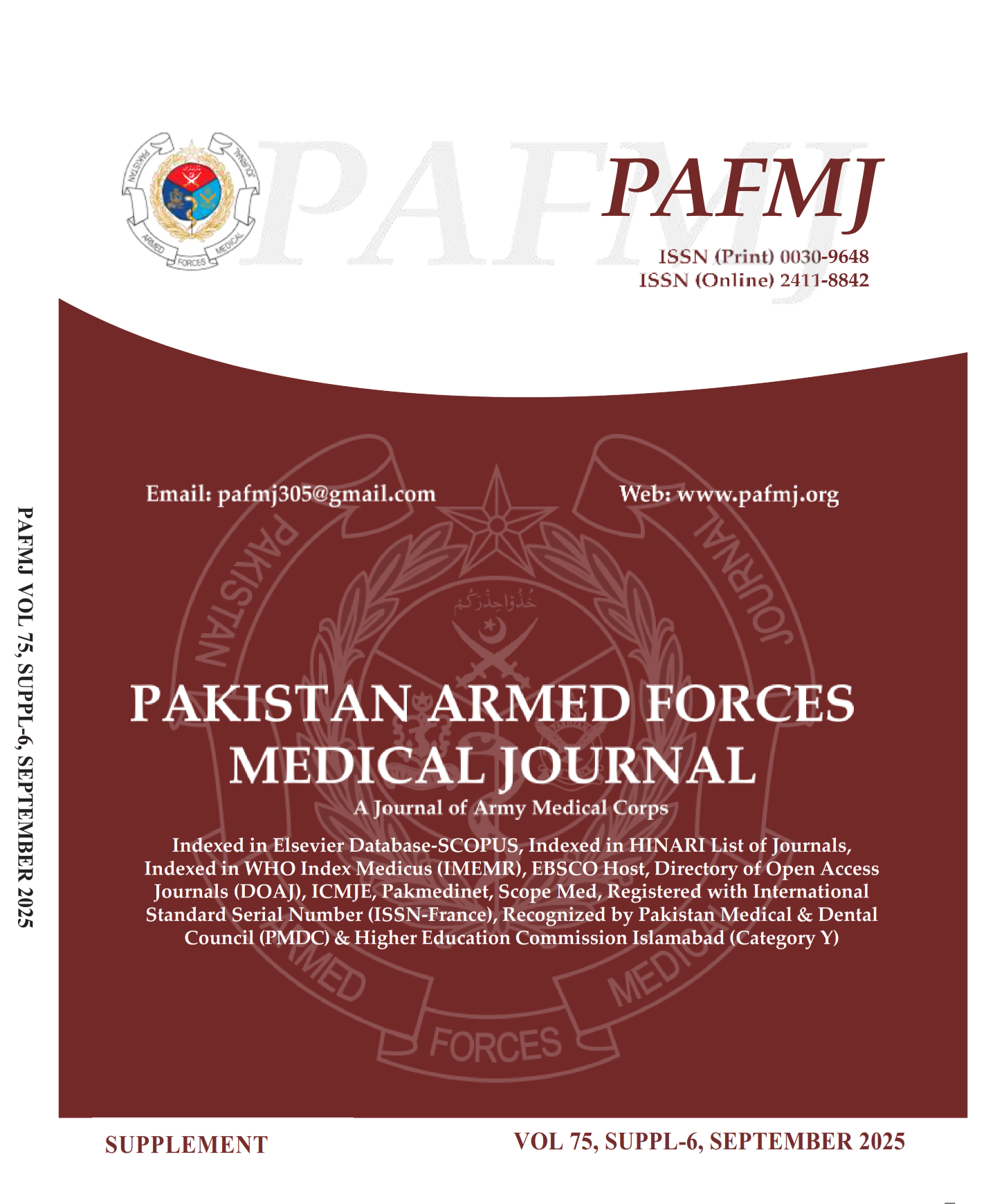Barriers to Continuing Medical Education Among Doctors in Tertiary Care Hospitals of Pakistan: a Descriptive Cross-Sectional Study
DOI:
https://doi.org/10.51253/pafmj.v75iSUPPL-6.13492Keywords:
Continuing, Education, Medical, PhysiciansAbstract
Objective: To assess the barriers to Continuing Medical Education (CME) among doctors in tertiary care hospitals of Pakistan.
Study Design: Cross-sectional study.
Place and Duration of Study: Public and private tertiary care hospitals of Rawalpindi and Islamabad, Pakistan, from Feb 2025 to Apr 2025.
Methodology: This study was conducted on doctors working in tertiary care hospitals of Rawalpindi and Islamabad using a structured, self-administered questionnaire. A total of 417 responses were collected through online and paper-based surveys.
Results: Out of 417 respondents, only 43.2% had attended a CME activity in the past year. The primary barriers identified were lack of time due to heavy workload (63%), high cost of participation (34%), and limited local access to CME programs (26%). To address time constraints, the most preferred solution was integrating CME into work hours (42.9%), followed by shorter or flexible sessions (29%) and online programs (25.4%). For financial barriers, employer-sponsored programs (33.3%), lower registration fees (27.6%), and free online options (27.3%) were the top recommendations. Workshops and hands-on training were the most favored CME formats (59%), and opinions on mandatory CME for license renewal were nearly evenly split.
Conclusion: CME participation among doctors is hindered primarily by time and financial constraints. Institutional support through work-integrated CME, financial assistance, and flexible delivery formats can significantly enhance participation. Policy-level interventions are needed to ensure equitable access and sustained professional development.
Downloads
References
1. Fox RD, Bennett NL. Continuing medical education: Learning and change—Implications for continuing medical education. BMJ 1998; 316(7129): 466–468.
https://doi.org/10.1136/bmj.316.7129.466
2. Reis T, Faria I, Serra H, Xavier M. Barriers and facilitators to implementing a continuing medical education intervention in a primary health care setting. BMC Health Serv Res 2022; 22(1): 1–9. https://doi.org/10.1186/s12913-022-08019-w
3. Vakani FS, Demirkol A, Uebel K, Balasooriya C. CME providers’ experiences and practices in Pakistan: a case study. BMC Med Educ 2024; 24(1): 1–9.
https://doi.org/10.1186/s12909-024-05201-y
4. Allen LM, Balmer D, Varpio L. Physicians' lifelong learning journeys: A narrative analysis of continuing professional development struggles. Med Educ 2024; 58(5): 481–491.
https://doi.org/10.1111/medu.15375
5. Cutrer WB, Spickard WA III, Triola MM, Allen BL, Spell N III, Herrine SK, et al. Exploiting the power of information in medical education. Med Teach 2021; 43(sup2): S17–S24.
https://doi.org/10.1080/0142159X.2021.1925234
6. Felch WC, Scanlon DM. Bridging the gap between research and practice: the role of continuing medical education. JAMA 1997 Jan 8; 277(2): 155–156.
7. Cantillon P, Jones R. Does continuing medical education in general practice make a difference? BMJ. 1999 May 8; 318(7193): 1276. https://doi.org/10.1136/bmj.318.7193.1276
8. Safdar A, Jamal S, Khan MA, Ahmed G. Continuing Professional Development (CPD) Pak Armed Forces Med J 2010; 60(3).
9. Abrahamson S, Baron J, Elstein AS, Hammond WP, Holzman GB, Marlow B, et al. Continuing medical education for life: eight principles. Acad Med. 1999 Dec; 74(12): 1288–1294.
https://doi.org/10.1097/00001888-199912000-00008
10. Neate SL, Dent AW, Weiland TJ, Farish S, Jolly B, Crotty BC et al. Barriers to continuing medical education in Australian prevocational doctors. Aust Health Rev. 2008; 32(2): 292–300.
https://doi.org/10.1071/ah080292
11. Cook DA, Blachman MJ, Price DW, West CP, Berger RA, Wittich CM. Professional development perceptions and practices among U.S. physicians: A cross-specialty national survey. Acad Med 2017; 92(9): 1335–1345.
https://doi.org/10.1097/ACM.0000000000001624
12. Ibsen H, Ahrenfeldt LJ, Lykkegaard J, Søndergaard J, Švab I, Kjaer NK et al. Barriers for continuous medical education: a cross-sectional questionnaire study among Danish GPs. BJGP Open 2024; 8(1): 1–9. https://doi.org/10.3399/BJGPO.2023.0228
13. Shah N, Soomro M, Musharraf M, Shaikh S. Mixed method survey to assess the problems and propose solutions for implementation of CME/CPD in Sindh, Pakistan. Pak J Med Sci 2019; 35(2): 555–560. https://doi.org/10.12669/pjms.35.2.243
14. Price DW, Overton CC, Duncan JP, Wamsley DA, Havens C, Steinbruegge J, et al. Results of the first national Kaiser Permanente continuing medical education needs assessment survey. Perm J 2002; 6(3): 16–24.
https://doi.org/10.7812/TPP/02.990
15. Mueller MR, Croghan IT, Schroeder DR, Bhuiyan MN, Ganesh R, Mohabbat AB et al. Physician preferences for online and in-person continuing medical education: a cross-sectional study. BMC Med Educ 2024; 24(1): 1142.
https://doi.org/10.1186/s12909-024-06046-1
16. Sherman L, Aboulsoud S, Chappell K. An overview of continuing medical education/continuing professional development systems in the Middle East and North Africa: A mixed methods assessment. J CME 2024; 13(1).
https://doi.org/10.1080/28338073.2024.2435737
17. Ruadze E, Cherkezishvili E, Roma E, Walsh K, Gabunia T, Gamkrelidze A et al. Multistakeholder perspectives on the strengthening and embedding of mandatory continuing medical education in Georgia: a qualitative study. BMJ Open 2024; 14(1): e067123.
https://doi.org/10.1136/bmjopen-2021-052686
18. Younes NA, AbuAlRub R, Alshraideh H, Abu-Helalah MA, Alhamss S, Qanno' O et al. Engagement of Jordanian physicians in continuous professional development: current practices, motivation, and barriers. Int J Gen Med 2019; 12: 475–83.
Downloads
Published
License
Copyright (c) 2025 Amna Ahmed, Mehwish Abbas, Saba Khurshid

This work is licensed under a Creative Commons Attribution-NonCommercial 4.0 International License.















